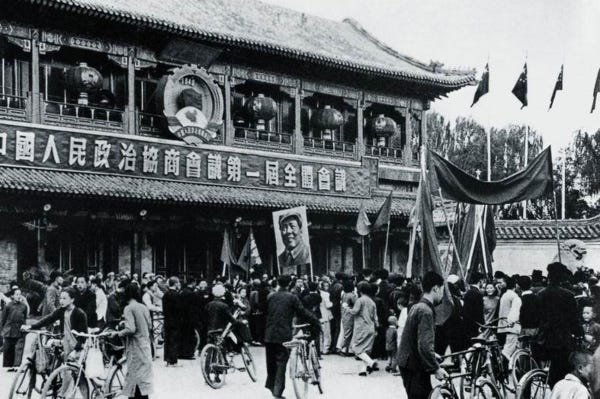China’s Political Consultation System: The Part of Chinese Politics the West Never Understood
Why China built a system to reduce conflict, while America built one that profits from it
The System the West Has Never Understood
Most Western commentary about China stops at one sentence: “China is a one party system.” That’s usually where the analysis begins and ends. One party, one leader, making every decision for 1.4 billion people.
That cartoonish level of understanding is exactly why Western analysts break down every time they try to explain why China stays politically stable while the U.S. feels like it’s being held together with duct tape.
There is an entire part of China’s political structure that they have never examined.
A system designed to absorb conflict instead of inflaming it.
A system that has no real equivalent in the Western world.
China calls it the political consultation system.
II. What the Consultation System Actually Does
The political consultation system is not a parliament and not a symbolic committee. It is a structured channel where different groups in society sit down with policymakers before conflict erupts into chaos.
These groups include:
medical professionals
engineers and scientists
educators
minority communities
business owners
researchers
community representatives
They walk into the room with real data and real problems. They discuss issues before they explode into national crises.
In the U.S., issues like housing, policing, education, or environmental conflict rarely enter a structured discussion. They go straight into the media machine and become political ammunition.
III. Why This System Absorbs Pressure Instead of Weaponizing It
China’s model forces early conversation. America’s model rewards theatrics.
In China, the goal is to cool things down:
What is the actual problem?
Who is affected?
What are the tradeoffs?
What solution is realistic?
It is not perfect, but it absorbs pressure. It prevents problems from turning into culture war explosions.
In the U.S., the moment a conflict appears, it enters:
cable news
social media
election messaging
partisan warfare
The goal becomes making the other side look bad, not solving anything. That is why the political temperature never resets. Every issue becomes fuel.
IV. The Eight Democratic Parties: Expertise, Not Opposition
Western audiences are often shocked to learn that China has eight democratic parties. They are not opposition parties in the Western sense. They are professional political groups representing:
scientists
educators
legal experts
business communities
engineers and researchers
Joining these groups is difficult. You have to be the best in your field.
Their job is to conduct deep investigations and deliver detailed reports directly to policymakers.
Compare that to the U.S., where political influence comes from:
corporate lobbying
billionaire-funded think tanks
media pressure campaigns
This raises a simple question: which system gives ordinary people more representation?
More about the eight democratic parties,
China’s “Multi-Party” System: Why It’s Not Just One-Party Rule
V. The Historical Origin: China Learned the Hard Way
China did not invent this model by accident. It emerged after a century of internal fragmentation. The late Qing collapse, warlord era, and Republican factionalism taught China a brutal lesson: without a political mechanism to manage conflict, the country tears itself apart.
That is why the modern Chinese state was born through the first political consultation conference in 1949. Consultation was built into the country from day one.
It was designed to prevent China from returning to chaos.
VI. Why the System Still Matters Today
Modern China is far too large, too diverse, and too complex to rely solely on electoral cycles. You need a mechanism that can:
absorb criticism
bring in expert knowledge
give small groups a structured voice
identify early signs of conflict
offer a long term planning space
reduce the emotional temperature of politics
The consultation system does this. It keeps national decision making from becoming hostage to short term outrage.
VII. Limitations of the System
No political system is perfect. The consultation model has its limits:
not every opinion gets adopted
some sectors have louder voices
local execution can be uneven
some consultations move slowly
quality depends on local leadership
But at its core, it works as intended. It transforms pressure into policy discussion instead of conflict.
That alone makes it fundamentally different from the American approach.
VIII. Why This Matters for America Right Now
America’s deepest crisis is political fragmentation. Every disagreement becomes a culture war battlefield. Every policy debate becomes identity warfare. The country no longer has a mechanism to absorb conflict. It turns every conflict into content.
This is not a cultural issue. It is a structural flaw.
A system that cannot process disagreement eventually gets consumed by it.
China built a pressure absorbing structure. America built a pressure amplifying one.
IX. Final Thoughts: A Society Survives by How It Handles Disagreement
China’s political consultation system is not mysterious or ideological. It is a political engineering solution designed to prevent fragmentation. America’s system is not inherently bad, but it was built for a different era. It is struggling to survive in a hyper polarized environment.
The future will belong to systems that can handle conflict without self destruction.
China chose negotiation as a habit.
America chose confrontation as an identity.
That is the real difference.


So interesting to have Chinese system explained . Thank you. Your content is interesting